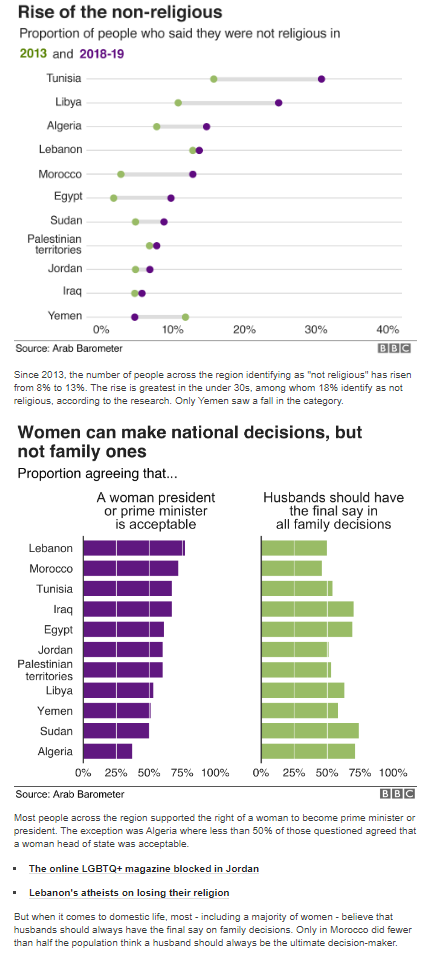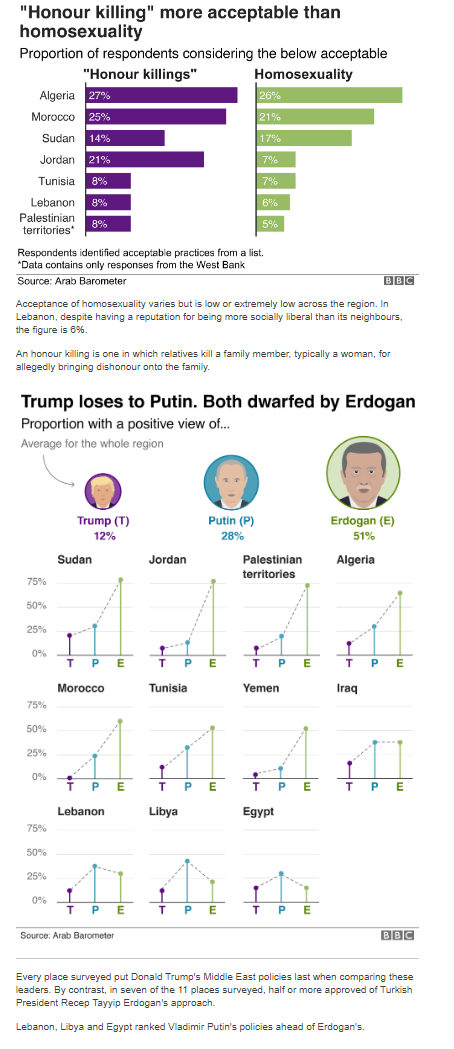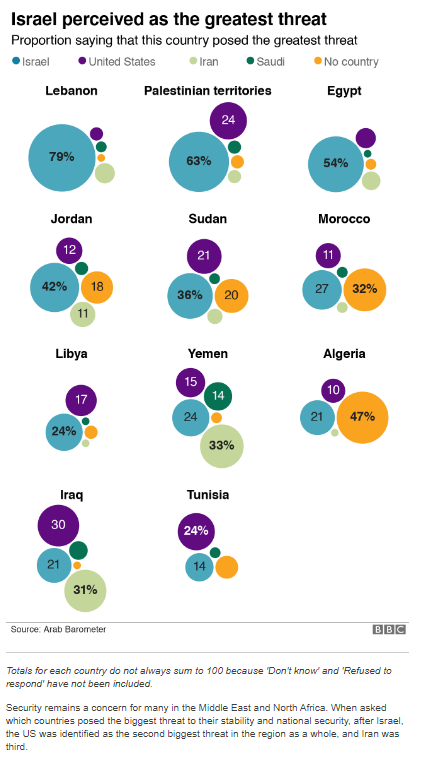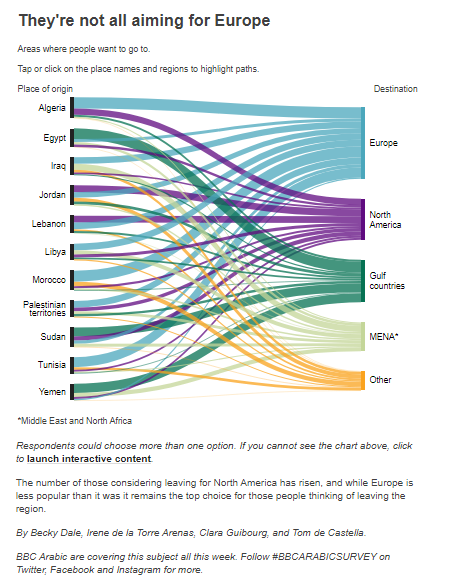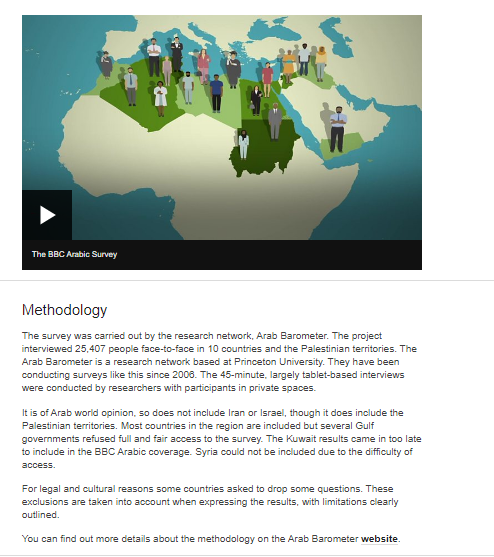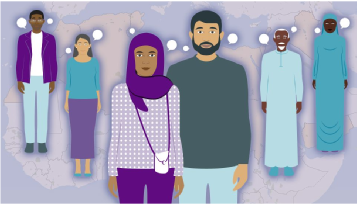|
|
|
CLICK BUTTON TO GO TO |
|
|
|
|
|
|
JewishWikipedia.info
|
PART 1 T O P I C |
|
|
|
|
|
|
|
|
|
|
|
|
|
|
|
|
|
|
THE WORLD’S MUSLIMS: UNITY AND DIVERSITY
(The survey involved more than 38,000 face-to-face interviews
in over 80 languages in 2012)
Pew Research Centre, August 2012
Infographic: The World’s Muslims: Unity and Diversity
Pew Research Centre, August 2012
Comment on Survey
Council for Foreign Affairs
See below for BBC ‘The Arab World in Seven Charts, 2019
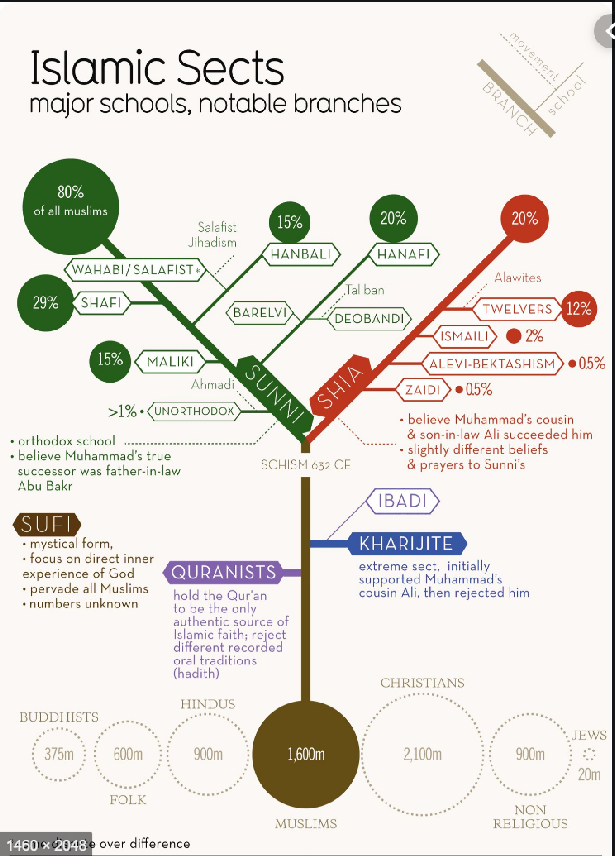
THE ARAB WORLD IN SEVEN CHARTS:
Are Arabs turning their backs on religion?
BBC 24 June 2019
Arabs are increasingly saying they are no longer religious, according to the largest and most in-depth survey undertaken of the Middle East and North Africa.
The finding is one of a number on how Arabs feel about a wide range of issues, from women's rights and migration to security and sexuality.
More than 25,000 people were interviewed for the survey - for BBC News Arabic by the Arab Barometer research network - across 10 countries and the Palestinian territories between late 2018 and spring 2019.
WHAT IS ISLAM?
Wikipedia
Islam (/ˈɪslɑːm/;[note 1] Arabic: الإسلام, al-ʾIslām IPA: [alʔisˈlaːm] ( listen)[note 2]) is a monotheistic and Abrahamic religion articulated by the Qur'an, a religious text considered by its adherents to be the verbatim word of God (Allāh), and, for the vast majority of adherents, by the teachings and normative example (called the sunnah, composed of accounts called hadith) of Muhammad (c. 570–8 June 632 CE), considered by most of them to be the last prophet of God. An adherent of Islam is called a Muslim (sometimes spelled "Moslem"). Muslims believe that God is one and incomparable[2] and that the purpose of existence is to worship God.
Muslims also believe that Islam is the complete and universal version of a primordial faith that was revealed many times before through prophets including Adam, Noah, Abraham, Moses, and Jesus. As for the Qur'an, Muslims consider it to be both the unaltered and the final revelation of God. Religious concepts and practices include the five pillars of Islam, which are obligatory acts of worship, and following Islamic law, which touches on virtually every aspect of life and society, from topics ranging from banking and welfare, to family life and the environment.Islam began in the early-7th century. Originating in Mecca, it quickly spread in the Arabian peninsula and by the 8th century the Islamic empire was extended from Iberia in the west to the Indus river in the east. The Islamic Golden Age refers to the period traditionally dated from the 8th century to the 13th century when much of the historically Islamic world was experiencing a scientific, economic and cultural flourishing. The expansion of the Muslim world involved various caliphates and empires, traders and conversion to Islam by missionary activities.
Most Muslims are of two denominations Sunni (75–90%) or Shia (10–20%). About 13% of Muslims live in Indonesia,[16] the largest Muslim-majority country, 32% in South Asia, 20% in the Middle East, and 15% in Sub-Saharan Africa. Sizable Muslim communities are also found in Europe, China, Russia, and the Americas. Converts and immigrant communities are found in almost every part of the world. With about 1.6 billion followers or 23% of the global population, Islam is the second-largest religion by number of adherents and, according to many sources, the fastest-growing major religion in the world.
WHAT IS THE MUSLIM/ISLAMIC WORLD?
Wikipedia
The term Muslim world, also known as Islamic world and the Ummah (Arabic: أمة, meaning "nation" or "community" has different meanings. In a religious sense, the Islamic Ummah refers to those who adhere to the teachings of Islam, referred to as Muslims. In a cultural sense, the Muslim Ummah refers to Islamic civilization, exclusive of non-Muslims living in that civilization. In a modern geopolitical sense, the term "Islamic Nation" usually refers collectively to Muslim-majority countries, states, districts, or towns.
Although Islamic lifestyles emphasise unity and defence of fellow Muslims, schools and branches (see Shia–Sunni relations, for example) exist. In the past both Pan-Islamism and nationalist currents have influenced the status of the Greater Middle East.
As of 2015, over 1.7 billion or about 23.4% of the world population are Muslims. By the percentage of the total population in a region considering themselves Muslim, 24.8% in Asia-Oceania do, 91.2% in the Middle East-North Africa, 29.6% in Sub-Saharan Africa, around 6.0% in Europe, and 0.6% in the Americas.
SUNNI AND SHIA
The two major sects are Sunni and Shia
Sunni are orthodox, believe that Muhammad's father-in-law Abu Bakr succeeded him & venerate certain recoded oral traditions (hadith)
Shia who believe Muhammad's cousin & son-in-law Ali succeeded him, slightly different beliefs & prayers, emphasise different recorded oral traditions (Hadith)
The Economist, S.B May 28th 2013
Clashes between Islam's two big sects, the Sunni and the Shia, take place across the Muslim world. In the Middle East a potent mix of religion and politics has sharpened the divide between Iran’s Shia government and the Gulf states, which have Sunni governments. Last year a report by the Pew Research Centre, a think tank, found 40% of Sunnis do not consider Shia to be proper Muslims. So what exactly divides Sunni and Shia Islam and how deep does the rift go?
The argument dates back to the death in 632 of Islam’s founder, the Prophet Muhammad. Tribal Arabs who followed him were split over who should inherit what was both a political and a religious office. The majority, who would go on to become known as the Sunnis, and today make up 80% of Muslims, backed Abu Bakr, a friend of the Prophet and father of his wife Aisha. Others thought Muhammad’s kin the rightful successors. They claimed the Prophet had anointed Ali, his cousin and son-in-law—they became known as the Shia, a contraction of "shiaat Ali", the partisans of Ali. Abu Bakr’s backers won out, though Ali did briefly rule as the fourth caliph, the title given to Muhammad’s successors. Islam's split was cemented when Ali’s son Hussein was killed in 680 in Karbala (modern Iraq) by the ruling Sunni caliph’s troops. Sunni rulers continued to monopolise political power, while the Shia lived in the shadow of the state, looking instead to their imams, the first twelve of whom were descended directly from Ali, for guidance. As time went on the religious beliefs of the two groups started to diverge.
Today the world’s 1.6 billion Muslims all agree that Allah is the only God and Muhammad his messenger. They follow five ritualistic pillars of Islam, including Ramadan, the month of fasting, and share a holy book, the Koran. But while Sunnis rely heavily on the practice of the Prophet and his teachings (the “sunna”), the Shia see their ayatollahs as reflections of God on earth. This has led Sunnis to accuse Shia of heresy, while Shia point out that Sunni dogmatism has led to extremist sects such as the puritanical Wahhabis. Most Shia sects place importance on the belief that the twelfth and final imam is hidden (called "in occultation") and will reappear one day to fulfill divine will. Meanwhile, their sense of marginalisation and oppression has led to mourning ceremonies such as ashura, when followers flagellate themselves to commemorate Hussein’s death at Karbala.
There has never been a clash between the Shia and Sunni on the scale of the Thirty Years War, which saw Christian sects fight each other in 17th-century Europe with great loss of life. This is partly because the Shias, ever mindful of their minority status, retreated. The lines that divide Muslims in the Middle East today are being drawn by politics as much as by religion. The "Shia Crescent" that runs from Iran, through Mr Assad’s regime in Damascus to Hizbullah in Lebanon was once praised by Sunni figures. But the revolutions in the region have pitted Shia governments against Sunni Gulf states such as Saudi Arabia and Qatar, who have supported their co-religionists with cash. This is strengthening Sunni assertiveness and making the Shia feel more threatened than usual. In most cases, though, members of the two sects still live harmoniously together.
SUNNI AND SHIA MUSLIMS::
ISLAM'S 1,400-YEAR-OLD DIVIDE
The Independent, John Hall, 4 January 2016
THE GEOGRAPHICAL SPLIT OF SUNNIS AND SHIAS
Tensions between Saudi Arabia and Iran fundamentally boil down to two things – the battle to be the dominant nation in the Middle East and the fact the countries represent the regional strongholds of two rival branches of Islam.
The Kingdom of Saudi Arabia is ruled by a Sunni monarchy known as the House of Saud, with 90 per cent of the population adherents of their leaders’ faith. The Islamic Republic of Iran, meanwhile, is overwhelmingly Shia, with up to 95 per cent of nationals belonging to the denomination.
Both countries are major oil producers but while Saudi covers a significantly larger land mass, Iran’s population is more than twice the size.
It is the theological divide that really drives the wedge between the two countries, however, with each unable to accept the legitimacy of the other nation’s dominant faith.
WHAT CAUSED THE SUNNI-SHIA DIVIDE?
The Sunni-Shia conflict is 1,400 years in the making, dating back to the years immediately after the Prophet Mohammed’s death in 632.
The Prophet died without having appointed a successor leading to a massive split over the future of the rapidly growing religion – chiefly whether the religion’s next leader should be chosen by a kind of democratic consensus, or whether only Mohammed’s blood relations should reign.
The arguments are complicated but essentially boil down to the fact that Sunni’s believe the Prophets’ trusted friend and advisor Abu Bakr was the first rightful leader of Muslims or “caliph”, while Shias believe that Mohammed’s cousin and son-in-law Ali was chosen by Allah to hold the title.
Both men did eventually hold the title – Abu Bakr first until his death, and Ali fourth after two previous caliphs were assassinated – but the schism really hit over who should come next. While Sunni Muslims argue that their interpretation of Islam follows the Sunnah (ways of Mohammed), Shias argue that Ali was the rightful first caliph and only his descendants could claim to be the true leaders of Muslims.
The tension is not eased by a Hadith in which the Prophet was quoted as saying: “My Ummah (community) will be fragmented into seventy-three sects and all of them will be in the Hell fire except one.” Inevitably both Sunnis and Shias claim to be the one “pure” Islamic sect.
WHAT DOES EACH GROUP BELIEVE?
As with any division that lasts over a thousand years, the Sunni-Shia split led to each denomination developing its own unique cultures, doctrines and schools of thought.
While followers of either group range from the moderate to the extremist, Sunnis are largely focussed on the power of the God in the physical world, while Shias look more towards the rewards of the afterlife and as such place significant value in the celebration of martyrdom.
WHAT IS THE GEOGRAPHICAL SPLIT OF SUNNIS AND SHIAS?
The vast majority of the Muslims in the world are Sunni, amounting to as much as 85% of the religion’s adherents. They are spread all over the globe – from Morocco to Indonesia - and make up the dominant religion in North Africa and the Middle East.
Despite being members of the religious minority, the Saudi-backed Kingdom of Bahrain has long been ruled by the Sunni House of Khalifa. Equally Iraq was ruled by the Sunni Saddam Hussein for more than 20 years, during which time he brutally oppressed Shia Muslims.
The current conflict in Iraq is fuelled by sectarian rivalries too, which embattled President Bashar al-Assad and his family members of the Shia Alawite-sect, while many of the insurgent groups in his country – including the Islamic State terror group – are Sunni adherents.
And of course the current civil war in Yemen has become a sectarian proxy war, with Iran backing the Shia Houthi rebels who overthrew the country’s Sunni-dominated government, while a Saudi-led coalition has since intervened to reinstall the Sunni leadership.
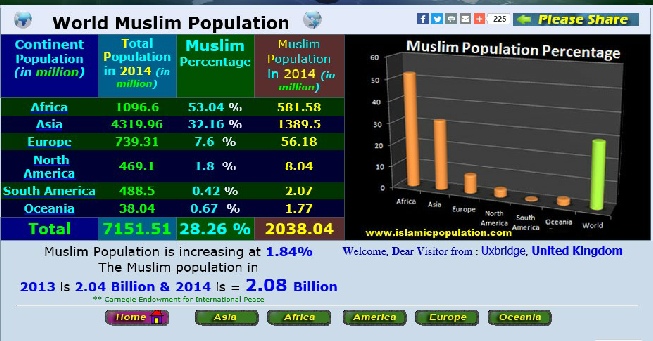
(click here for links to continents and countries)
THE ALAWITES OF SYRIA
About News ((Go to Syrian War for more information))
The differences between Alawites and Sunnis in Syria have sharpened dangerously since the beginning of the uprising against President Bashar al-Assad, whose family is Alawite. The reason for tension is primarily political, rather than religious: top positions in Assad’s army are held by Alawite officers, while most rebels from the Free Syrian Army are from Syria’s Sunni majority.
Geographical Presence: Alawites are a Muslim minority group that accounts for around 12% of Syria’s population, with a few small pockets in Lebanon and Turkey (though not to be confused with Alevis, a Turkish Muslim minority). Around 70% of Syrians belongs to Sunni Islam, as does almost 90% of all Muslims in the world).
Historical Alawite heartlands lie in the mountainous hinterland of Syria’s Mediterranean coast in the country’s west, next to the coastal city of Latakia. Alawites form the majority in Latakia province, although the city itself is mixed between Sunnis, Alawites and Christians. Alawites also have a sizeable presence in the central province of Homs and in the capital Damascus.
Doctrinal Differences: Alawites practice a unique but little known form of Islam that dates back to the 9th and 10th century. Its secretive nature is an outcome of centuries of isolation from the mainstream society and periodical persecution by the Sunni majority.
Sunnis believe that succession to prophet Mohammed (d. 632) rightly followed through the line of his most able and pious companions. Alawites follow the Shiite interpretation, claiming that succession should have been based on bloodlines. According to Shiite Islam, Mohammed’s only true heir, imam, was his son-in-law Ali bin Abu Talib.
But Alawites take a step further in the veneration of Imam Ali, allegedly investing him with divine attributes. Other specific elements such as the belief in divine incarnation, permissibility of alcohol, celebration of Christmas and the Zoroastrian new year makes Alawite Islam highly suspect in the eyes of many orthodox Sunnis and Shiites.
AHMADIYYA MUSLIM COMMUNITY
Wikipedia
It originated with the life and teachings of Mirza Ghulam Ahmad (1835–1908), who claimed to have fulfilled the prophecies of the world's reformer during the end times, who was to herald the Eschaton as predicted in the traditions of various world religions and bring about the final triumph of Islam as per Islamic prophecy. He claimed that he was the Mujaddid (divine reformer) of the 14th Islamic century, the promised Messiah and Mahdi awaited by Muslims. The adherents of the Ahmadiyya movement are referred to as Ahmadis or Ahmadi Muslims.
Ahmadis thought emphasizes the belief that Islam is the final dispensation for humanity as revealed to Muhammad and the necessity of restoring to it its true essence and pristine form, which had been lost through the centuries. Thus, Ahmadis view themselves as leading the revival and peaceful propagation of Islam. The Ahmadis were among the earliest Muslim communities to arrive in Britain and other Western countries.
Ahmadiyya adherents believe that God sent Ghulam Ahmad, in the likeness of Jesus, to end religious wars, condemn bloodshed and reinstitute morality, justice and peace. They believe that he divested Islam of fanatical beliefs and practices by championing what is in their view, Islam’s true and essential teachings as practised by Muhammad. The Ahmadiyya Community is the larger community of the two arising from the Ahmadiyya movement and is guided by the Khalifa (Caliph), currently Khalifatul Masih V, who is the spiritual leader of Ahmadis and the successor to Mirza Ghulam Ahmad. He is called the Khalifatul Masih(successor of the Messiah). .
Lahore Ahmadiyya Movement
Wikipedia Lahore Ahmadiyya Movement for the Propagation of Islam
The Lahore Ahmadiyya Movement also known as the Lahoris, formed as a result of ideological differences within the Ahmadiyya Muslim Community, after the demise of Maulana Hakim Noor-ud-Din in 1914, the first Khalifa after its founder, Mirza Ghulam Ahmad. The main dispute was based on differing interpretations of a verse [Quran 33:40] related to the finality of prophethood. Other issues of contention were the Kalima, funeral prayers, and the suitability of the elected Khalifa (2nd successor) Mirza Basheer-ud-Din Mahmood Ahmad (the son of the Founder). The Lahore Ahmadiyya Movement is led by a President or Emir.
(8) WAHHABIS
Frontline
For more than two centuries, Wahhabism has been Saudi Arabia's dominant faith. It is an austere form of Islam that insists on a literal interpretation of the Koran. Strict Wahhabis believe that all those who don't practice their form of Islam are heathens and enemies. Critics say that Wahhabism's rigidity has led it to misinterpret and distort Islam, pointing to extremists such as Osama bin Laden and the Taliban. Wahhabism's explosive growth began in the 1970’s when Saudi charities started funding Wahhabi schools (madrassas) and mosques from Islamabad to Culver City, California. Here are excerpts from FRONTLINE's interviews with Mai Yamani, an anthropologist who studies Saudi society; Vali Nasr, an authority on Islamic fundamentalism; Maher Hathout, spokesperson for the Islamic Center of Southern California; and Ahmed Ali, a Shi'a Muslim from Saudi Arabia. (Also see the Links and Readings section of this site for more analyses of Wahhabism and Saudi Arabia.)
If you go to school in Saudi Arabia, what do you learn about people who are not followers of Wahhabi, of the prophet?
The religious curriculum in Saudi Arabia teaches you that people are basically two sides: Salafis [Wahhabis], who are the winners, the chosen ones, who will go to heaven, and the rest. The rest are Muslims and Christians and Jews and others.
They are either kafirs, who are deniers of God, or mushrak, putting gods next to God, or enervators, that's the lightest one. The enervators of religion who are they call the Sunni Muslims who ... for instance, celebrate Prophet Mohammed's birthday, and do some stuff that is not accepted by Salafis.
And all of these people are not accepted by Salafi as Muslims. As I said, "claimant to Islam." And all of these people are supposed to be hated, to be persecuted, even killed. And we have several clergy -- not one Salafi clergy -- who have said that against the Shi'a and against the other Muslims. And they have done it in Algeria, in Afghanistan. This is the same ideology. They just have the same opportunity. They did it in Algeria and Afghanistan, and now New York. …
4 QUESTIONS ISIS REBELS USE
TO TELL SUNNI FROM SHIA
The New York Times Alissa J Rubin, Jun 24, 2014
BAGHDAD: Whether a person is a Shia or a Sunni Muslim in Iraq can now be, quite literally, a matter of life and death. (See also Islam maps Syrian War Judaism and Islam -2 )
As the militant group the Islamic State in Iraq and Syria, or ISIS, has seized vast territories in western and northern Iraq, there have been frequent accounts of fighters' capturing groups of people and releasing the Sunnis while the Shias are singled out for execution.
ISIS believes that the Shias are apostates and must die in order to forge a pure form of Islam. The two main branches of Islam diverge in their beliefs over who is the true inheritor of the mantle of the Prophet Muhammad. The Shias believe that Islam was transmitted through the household of the Prophet Muhammad. Sunnis believe that it comes down through followers of the Prophet Muhammad who, they say, are his chosen people.
But how can ISIS tell whether a person is a Sunni or a Shia? From accounts of people who survived encounters with the militants, it seems they often ask a list of questions. Here are some of them:
What is your name? A quick look at an Iraqi's national identity card or passport can be a signal. Shias believe that the leadership of Islam was passed down through the Prophet Muhammad's son-in-law Ali and his sons Hussain (or Hussein), Hassan and Abbas, among others. While some Sunnis and members of other Islamic groups may also have those names, ISIS would most likely associate them with the Shias.
Where do you live? In every city and province, even majority Sunni ones, there are enclaves that are known to be Shia. People who said they came from one of those neighborhoods would most likely be killed.
How do you pray? Shias and Sunnis offer prayers in slightly different ways, with Sunnis generally folding their hands or crossing their arms in front of their stomachs and Shias leaving them extended, palms resting on their thighs.
In a chilling video that appeared to have been made more than a year ago in the Anbar Province of Iraq, ISIS fighters stopped three truck drivers in the desert and asked them whether they were Sunnis or Shias. All three claimed to be Sunni. Then the questions got harder. They were asked how they performed each of the prayers: morning, midday and evening. The truck drivers disagreed on their methods, and all were shot.
What kind of music do you listen to? Recordings of religious songs could also be a tipoff. Similarly, even the ringtone on a person's telephone could be a clue because it might be from a Sunni or Shia religious song.
There are other clues, but none are completely reliable. For instance, a number of Shias wear large rings, often with semiprecious stones. But so do some Sunnis, and others.
Shia–Sunni Relations Wikipedia
Islam Wikipedia
Islamic Schools and Branches Wikipedia
Islam in the United States Wikipedia
Key Islamic Sects, Branches and Movements Information is Beautiful
Islamic Sects, Major Schools and Branches Information is Beautiful
THE
INCREDIBLE
STORY OF THE JEWISH PEOPLE

|
|
|
|
|
|
|
|
